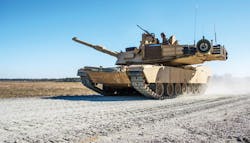General Dynamics to upgrade Abrams main battle tanks and vetronics to SEPv3
WARREN, Mich. - Armored combat vehicle experts at General Dynamics Corp. will upgrade 45 M1 Abrams main battle tanks and vetronics to the most advanced M1A2 system enhancement package version 3 (SEPv3) configuration under terms of a $270.2 million contract.
Officials of the U.S. Army Contracting Command in Warren, Mich., are asking General Dynamics Land Systems in Sterling Heights, Mich., to install and integrate SEPv2 legacy unique components resulting in 45 M1A2 SEPv3 Abrams Main Battle tanks.
The M1A2 SEPv3 main battle tank is the latest version of the M1 Abrams, and has increased power generation and distribution, better communications and networking, a new vehicle health management system (VHMS), line replaceable modules (LRMs) for improved maintenance, and an ammunition datalink (ADL) to use airburst rounds.
The contract also asks General Dynamics Land Systems to procure, stock, and store 60 sets of SEPv2 legacy and SEPv3 unique components, procure integrated product support requirements, special tooling and test equipment, and the systems support package.
This latest version of the M1A2 tank also offers an improved counter-improvised explosive device (IED) armor package, improved forward-looking infrared (FLIR) sensor using long- and mid-wave infrared, a low-profile Common Remotely Operated Weapon Station (CROWS), and an auxiliary power unit (APU) under armor to run electronics without the engine running.
Prototypes of the M1A2 SEPv3 tank began testing in 2015, and should enter service this year. Improvements to the SEPv3 version focus on increasing the electrical power; improving survivability; integrating the new Army network; electronic component improvements; new auxiliary power unit; and an ammunition data link.
The M1A2 SEPv3 is the next-generation M1 tank version from the SEPv2, which focused on improved survivability, automotive power pack, computer systems, and night-vision capabilities. The SEPv2 also offered improvements in the CROWS and ballistic solution upgrades for the M829A3 kinetic and the M1028 canister rounds.
The M1A2 SEPv2 has improved microprocessors, color flat-panel displays, improved memory capacity, better soldier-machine interface, and a new open operating system designed to run the Common Operating Environment software. The tank gunner's primary sight and the commander's independent thermal viewer include the improved thermal imaging capabilities of the new Block I 2nd generation FLIR technology.
Army leaders intend the M1A2 SEPv3 to defeat and suppress enemy tanks, reconnaissance vehicles, infantry fighting vehicles, armored personnel carriers, anti-tank guns, guided missile launchers, bunkers, infantry, and helicopters.
On this contract, General Dynamics will do the work in Lima, Ohio; Scranton, Pa.; Anniston, Ala.; and Tallahassee, Fla., and should be finished by August 2019.
FOR MORE INFORMATION visit General Dynamics Land Systems online at www.gdls.com, or the Army Contracting Command in Warren, Mich., at acc.army.mil/contractingcenters/acc-wrn.

